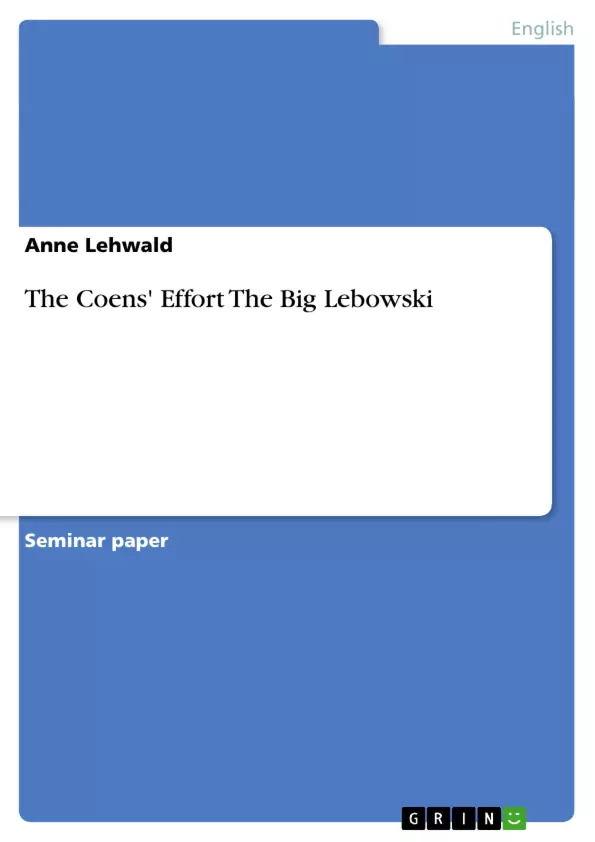In this paper for the seminar “Outstanding Film Directors“ I want to analyze the movieThe Big Lebowski (TBL)by Joel and Ethan Coen. Released in 1998TBLis the seventh effort of the Coen brothers and - afterRaising Arizona(1987) andFargo(1996) - their third movie that deals with kidnapping.TBLhas been praised by most authors of the feature pages of newspapers and magazines. For Jan Distelmeyer, author of the magazine Spex, for example,TBLis an `extremly entertaining tasty morsel` (in www.gezetera.ch). The main characters´ favorite cocktail, White Russian, has become a cult drink not only amongTBL-fans. While the audience for the most part enjoy the laconic irony of the Coens´ hommage to the hard-boiled classics of Raymond Chandler, some academics question the significance of the movie. R. Barton Palmer, director of the South Carolina Film Institute, believes thatTBLadds only little importance to the general account of the Coens´ place within the history of the contemporary American filmmaking scene (6).
In this paper I want to introduce the Coen brothers and their typical style that is even referred to as “Coen-esque”. The indepth analysis of their effortTBLis the principal concern of this paper. After a brief introduction of the plot and the characters I will analyze the references and allusions that occur inTBL.The meaning of the music and the peculiarities of the dialo gs are also being discussed. The analysis of the used imagery inTBLand some of the emerging postmodern elements are also subjects of discussion.
The Coen brothers refuse to intellectualize and stress the fact that they “simply” want to entertain their audience. With this paper I want to show thatTBLis much more than 112 minutes of entertainment. It is a political statement and a perfect cinematic symbiosis of pictures, music, and dialogs.
Inhaltsverzeichnis (Table of Contents)
- Prologue
- The Universe of Joel and Ethan Coen
- Biography - Filmography – Philosophy
- The Style of the Coen Brothers
- The Coens Effort The Big Lebowski
- The Plot
- The Characters
- Analysis of The Big Lebowski
- References and Allusions
- Music and Dialogs
- Imagery: Symbols and Metaphors
- Postmodern Elements
- Epilogue
Zielsetzung und Themenschwerpunkte (Objectives and Key Themes)
This paper analyzes the Coen brothers’ film The Big Lebowski (TBL) by focusing on its references, allusions, music, dialogues, and imagery. The paper aims to show that TBL is much more than just entertainment; it is a political statement and a cinematic symbiosis of pictures, music, and dialogues.
- The Coen brothers' unique style and their use of humor and irony.
- The references and allusions in TBL to other films, literature, and culture.
- The role of music and dialogue in creating the film's unique atmosphere.
- The use of imagery, symbols, and metaphors to convey meaning in TBL.
- The postmodern elements present in TBL.
Zusammenfassung der Kapitel (Chapter Summaries)
The paper begins with an introduction to the Coen brothers and their filmography, highlighting their distinctive style. The chapter then delves into a detailed analysis of The Big Lebowski, exploring its plot, characters, and cinematic techniques. The analysis focuses on the film's references, allusions, use of music and dialogue, imagery, and postmodern elements. The chapter concludes with a discussion of the film's significance and impact.
Schlüsselwörter (Keywords)
The main keywords and focus topics of this paper are: Coen brothers, The Big Lebowski, film analysis, references, allusions, music, dialogue, imagery, postmodernism, cinematic style, humor, irony, American cinema.
- Arbeit zitieren
- Anne Lehwald (Autor:in), 2005, The Coens' Effort The Big Lebowski, München, GRIN Verlag, https://www.grin.com/document/47359



